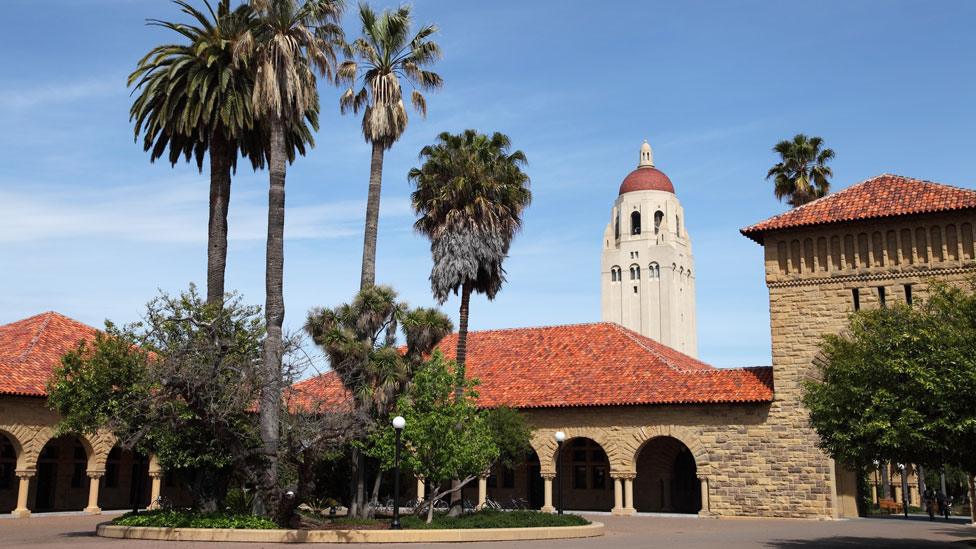Where do unicorns go to university?
- Published

What's the stamping ground for the elusive group of start-up billionaires known as "unicorns"?
Unicorns are rare beasts - not only creatures of myths but also, in the financial sector, the almost magical makers of money.
The term "unicorn" is used to describe start-ups that have grown from nothing to be worth at least a billion dollars.
It's tough enough for start-ups to make any money, but to go from an idea sketched on an envelope to making a billion is uber-unusual.
And Uber is one of these tech-powered unicorns.
But what is their natural habitat? Where are these unicorns likely to have been trained?
Financial elites
In terms of their universities, there doesn't seem to be any romantic fairytale beginning for would-be unicorns.
They are not self-taught entrepreneurs, but are more likely to have gone to expensive and highly-selective institutes.

The unicorns have made their money in online businesses
A league table, external, drawn up by international accountancy software firm Sage, shows that members of this financial elite are likely to have had an elite education.
The top of the table by some distance is Stanford University in California, an institution that has been integral to the growth of Silicon Valley.
Builders of "knowledge hubs" or "tech hubs" around the world have sought to replicate Silicon Valley's mixture of academic research, business innovation and supportive investors.
And this unicorn league shows Stanford accelerating quickly in this competition for successful start-ups.
Tech moguls
Harvard, the world's wealthiest university, is in second place, with US institutions taking nine of the top 15 places, with many of these entries dominated by tech start-ups.
The first non-US university is in fourth place with a combined figure for all the Indian Institutes of Technology.
This network of 23 institutions across India has a notoriously competitive entrance exam - often claimed to be the most oversubscribed applications process in the world.

Stanford University has been the most popular starting point for unicorns
The UK's entry in this unicorn league is Oxford University in seventh place. Although the London School of Economics also features in the following pack, just outside the top 15.
France, Israel, Germany and Canada all make a single appearance in the rankings. In Canada, there is a sub-species of unicorns, referred to as "narwhals" (whales, sometimes referred to as the unicorns of the sea).
So why are these unicorns concentrated in these universities?
Prof Frank Furedi, author and social commentator, said that on visits to top US universities he had been struck by the self-confidence of such young student entrepreneurs.
"There is a sense of enormous possibilities... everything in that culture reinforces that," he says.

More stories from the BBC's Global education series, external looking at education from an international perspective, and how to get in touch.
You can join the debate at the BBC's Family & Education News Facebook page, external.

These universities provide networks of like-minded, ambitious, competitive youngsters, who expect to have online start-ups that can accelerate much more quickly than traditional businesses.
He says that often these young entrepreneurs might be at old and prestigious universities, but they are often from immigrant families.
Don't follow the herd
If these new billionaires are clustered in a narrow pool of universities, the gender breakdown is even less inclusive - with men accounting for 94% of the unicorns.
A third of these unicorns were solo entrepreneurs - while the other two-thirds were co-founders.
Perhaps what's more surprising is that for 60% of the unicorns, this was their first business. And for a further 23% it was their second - suggesting that for a considerable majority there was no back-story of failure.
And the most typical time for reaching unicorn status was four years after founding - although there were firms that took up to 30 years to turn into a billion-dollar shaped unicorn.

India's elite technology institutes are the nearest rivals to the US unicorns
The number of unicorns rose sharply in the years after 2012 and peaked in 2015, before slipping down again in 2016.
Of course, as well as admiring the unicorns from a distance - there will be people wondering how they can get on board themselves.
Where would you find a unicorn?
Stanford's own business school has published advice saying that if you're looking for the next unicorn, "look for the horse running away from the herd".
They suggest that it's better not to look in the "rear-view mirror" for previous successes, but to look towards the so-far unknown.
But the evidence of this league table suggests that unicorns are not going to be found wandering around anything resembling traditional manufacture.
By far the biggest sector for unicorns is under the heading of "consumer internet", followed by financial services and e-commerce.
This financial alchemy is heavily driven by the online economy. Cloud computing seems to have a silver lining.
Unicorn stamping grounds
Stanford University
Harvard University
University of California
Indian Institutes of Technology
Massachusetts Institute of Technology
University of Pennsylvania
University of Oxford
Tel Aviv University
Cornell University
University of Southern California
University of Waterloo
INSEAD
WHU - Otto Beisheim Graduate School of Management
University of Michigan
Brigham Young University